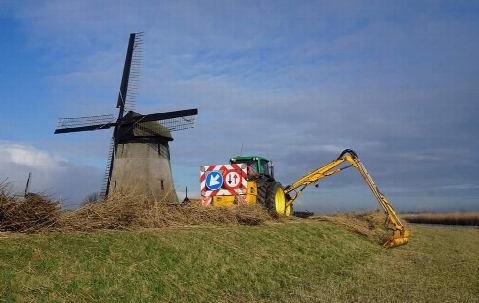Mowing of dikes
Previously, dikes were mowed two or three times a year for water safety. Today, we take more account of nature by mowing "to size.
Preferably outside the breeding season

At locations with nesting birds and/or protected species, we prefer to mow outside the breeding season (March 15 to July 15). If it is necessary for water safety, year-round mowing is allowed. The vegetation of these dikes is then already kept short at the beginning of the breeding season so that birds do not nest there. During the breeding season, we leave at least half of the vegetation standing so that birds, amphibians, reptiles, butterflies and other species can settle there. Also, in some cases, we inspect the dikes in advance to determine if there are nesting birds. Present bird nests are marked in advance and spared during mowing.
During the work pass, we pay close attention to nesting birds and other protected species.
Mowing levees for water safety
We mow the dikes for water safety: a good dike lining protects the dike and keeps the soil with the roots firmly together. An additional advantage is that mowing allows us to see better where bare spots or other damage needs to be repaired. At the same time, we take into account ecological values and recreational co-use, such as walking, cycling, fishing, etc.
Mowing is usually done mechanically by a contractor or by our own employees. We dispose of the clippings so that the vegetation does not suffocate and weeds such as thistles and nettles do not grow. In places where the slope is too steep and where there are too many trees, we leave the clippings. Sheep graze on 10-20% of our dikes to keep the vegetation short. Marijke Dirkson is the professional shepherd who carefully walks our dikes with her flock.
Hayland Management
Starting in 2020, we will introduce a new way of mowing maintenance, namely hay meadow management. This way of maintenance is most conducive to ecology. Mowing, raking and baling will be done after the breeding season (July 15). In total, this involves about 200 hectares where hay meadow management is applied. In addition, we are seeding 35 kilometers of dikes with a flowery mixture to promote biodiversity.